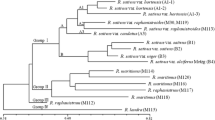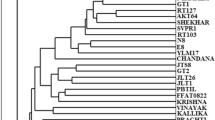Abstract
Ten snap bean (Phaseolus vulgaris) genotypes were screened for polymorphism with 400 RAPD (random amplified polymorphic DNA) primers. Polymorphic RAPDs were scored and classified into three categories based on ethidium bromide staining intensity. An average of 5.19 RAPD bands were scored per primer for the 364 primers that gave scorable amplification products. An average of 2.15 polymorphic RAPDs were detected per primer. The results show that primer screening may reduce the number of RAPD reactions required for the analysis of genetic relationships among snap-bean genotypes by over 60%. Based on the analysis of the distribution of RAPD amplification, the same number of polymorphic RAPDs were amplified from different genotypes for all RAPD band intensity levels. A comparison of RAPD band amplification frequency among genotypes for the three categories of bands classified by amplification strength revealed a measurable difference in the frequencies of RAPDs classified as faint (weakly amplifying) compared to RAPD bands classified as bold (strongly amplifying) indicating a possible scoring error due to the underscoring of faint bands. Correlation analysis showed that RAPD bands amplified by the same primer are not more closely correlated then RAPD bands amplified by different primers but are more highly correlated then expected by chance. Pairwise comparisons of RAPD bands indicate that the distribution of RAPD amplification among genotypes will be a useful criterion for establishing RAPD band identity. For the average pairwise comparison of genotypes, 50% of primers tested and 15.8% of all scored RAPDs detected polymorphism. Based on RAPD data Nei's average gene diversity at a locus was 0.158 based on all scorable RAPD bands and 0.388 if only polymorphic RAPD loci were considered. RAPD-derived 1 relationships among genotypes are reported for the ten genotypes included in this study. The data presented here demonstrate that many informative, polymorphic RAPDs can be found among snap bean cultivars. These RAPDs may be useful for the unique identification of bean varieties, the organization of bean germplasm, and applications of molecular markers to bean breeding.
Similar content being viewed by others
References
Adriaanse A, Klop W, Robbers JE (1969) Characterization of Phaseolus vulgaris cultivars by their electrophoretic patterns. J Sci Fd Agric 20:647–650
Bassiri A, Adams MW (1978) Evaluation of common-bean cultivar relationships by means of isozyme electrophoretic patterns. Euphytica 27:707–720
Brown JWS, McFerson JR, Bliss FA, Hall TC (1982) Genetic divergence among commercial classes of Phaseolus vulgaris in relation to phaseolin pattern. Hortscience 17:752–754
Dos Santos JB, Nienhuis J, Skroch P, Tivang J, Slocum MK (1994) Comparison of RAPD and RFLP genetic markers in determining genetic similarity among Brassica oleracea L. genotypes. Theor Appl Genet 87:909–915
Gepts P (1990) Biochemical evidence bearing on the domestication of Phaseolus (Fabaceae) beans. Econ Bot 44 (Supplement 3): 28–38
Gepts P, Osborn TC, Rashka K, Bliss FA (1986) Phaseolin protein variability in wild forms and landraces of common bean (Phaseolus vulgaris): evidence for multiple centers of domestication. Econ Bot 40:451–468
Gepts P, Nodari RSM, Tsai, Koinage EMK, Liaca V, Gilbertson R, Guzman P (1993) Linkage mapping in common bean. Annu Rep Bean Improv Coop 36:24–38
Gower JC (1972) Measures of taxonomic distances and their analysis. In: Weiner JS, Huizinga J (eds) The assessment of population affinities in man. Clarendon Press, Oxford, pp 1–24
Haley SD, Miklas PN, Afanador L, Kelly JD (1994) Random amplified polymorphic DNA (RAPD) marker variability between and within gene pools of common bean. J Am Soc Hort Sci 119:122–125
Heun M, Helentjaris T (1993) Inheritance of RAPDs in F1 hybrids of corn. Theor Appl Genet 85:961–968
Huang LM, Jeang KT (1994) Long-range jumping of incompletely extended polymerase chain fragments generates unexpected products. Biotechniques 16:242–246
Kelly JD, Stavely R, Miklas P, Afanador L, Haley SD (1993) Pyramiding rust resistance genes using RAPD markers. Annu Rep Bean Improv Coop 36:166–167
Kennard WC, Poetter K, Dijkhuizen A, Meglic V, Staub JE, Havey MJ (1994) Linkages among RFLP, RAPD, isozyme, diseaseresistance, and morphological markers in narrow and wide crosses of cucumber. Theor Appl Genet 89:42–48
Koenig RL, Singh SP, Gepts P (1990) Novel phaseolin types in wild and cultivated common bean (Phaseolus vulgaris, Fabaceae). Econ Bot 44:50–60
Miklas PN, Stavely JR, Kelly JD (1993) Identification and potential use of a molecular marker for rust resistance in common bean. Theor Appl Genet 85:745–749
Nei M (1987) Molecular evolutionary genetics. Columbia university press, New York
Nodari RO, Koinange EMK, Kelly JD, Gepts P (1992) Towards an integrated linkage map of common bean. 1. Development of genomic DNA probes and levels of restriction fragment length polymorphism. Theor Appl Genet 84:186–192
Penner GA, Bush A, Wise R, Kim W, Domier L, Kaasha K, Laroche A, Scoles G, Molnar SJ, Fedak G (1993) Reproducibility of random amplified polymorphic DNA (RAPD) analysis among laboratories. PCR Methods Applic 2:341–345
Rogers SO, Bendich AJ (1988) Extraction of DNA from milligram amounts of fresh, herbarium and mummified plant tissues. Plant Mol Biol 5:69–76
Singh SP, Gepts P, Debouck DG (1991a) Races of common bean (Phaseolus vulgaris, Fabaceae) Econ Bot 45:379–396
Singh SP, Gutierrez JA, Molina A, Urrea C, Gepts P (1991b) Genetic diversity in cultivated common bean. 1. Allozymes. Crop Sci 31:19–23
Skroch PW, Nienhuis J (1995) Impact of scoring error and reproducibility of RAPD data on RAPD-based estimates of genetic distance. Theor Appl Genet 91:1086–1091
Skroch PW, dos Santos JB, Nienhuis J (1992a) Genetic relationships among Phaseolus vulgaris genotypes based on RAPD marker data. Annu Rep Bean Improv Coop 35:23–24
Skroch PW, Tivang J, Nienhuis J (1992b) Analysis of genetic relationships using RAPD marker data. In: Applications of RAPD Technology to Plant Breeding. Crop Science Society of America, Madison, Wisconsin, pp 26–30
Stiles JI, Lemme C, Sondur S, Morshidi MB, Manshardt R (1993) Using randomly amplified polymorphic DNA for evaluating genetic relationships among papaya cultivars. Theor Appl Genet 85:697–701
Tinker NA, Fortin MG, Mather DE (1993) Random amplified polymorphic DNA and pedigree relationships in spring barley. Theor Appl Genet 85:976–984
Vierling RA, Nguyen HT (1992) Use of RAPD markers to determine the genetic diversity of diploid, wheat genotypes. Theor Appl Genet 84:835–838
Weeden NF (1984) Distinguishing among white-seeded bean cultivars by means of allozyme genotypes. Euphytica 33: 199–208
Weeden NF, Timmerman GM, Hemmat M, Kneen BE, Lofhi MA (1992) Inheritance and reliability of RAPD markers. In: Applications of RAPD markers to plant breeding. Crop Science Society of America, pp 12–17
Williams JGK, Kubelik AR, Livak KJ, Rafalski JA, Tingey SV (1990) DNA polymorphisms amplified by arbitrary primers are useful as genetic markers. Nucleic Acids Res 18:651–6535
Yang X, Quiros C (1993) Identification and classification of celery cultivars with RAPD markers. Theor Appl Genet 86:205–212
Zaumeyer, WJ (1972) Genetic vulnerability of major crops. Natl Acad Sci, Washington, D. C., pp. 234–244
Author information
Authors and Affiliations
Additional information
Communicated by G. E. Hart
Rights and permissions
About this article
Cite this article
Skroch, P.W., Nienhuis, J. Qualitative and quantitative characterization of RAPD variation among snap bean (Phaseolus vulgaris) genotypes. Theoret. Appl. Genetics 91, 1078–1085 (1995). https://doi.org/10.1007/BF00223922
Received:
Accepted:
Issue Date:
DOI: https://doi.org/10.1007/BF00223922




